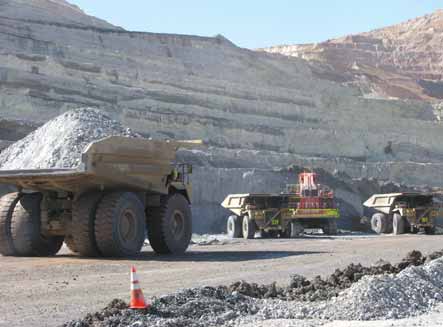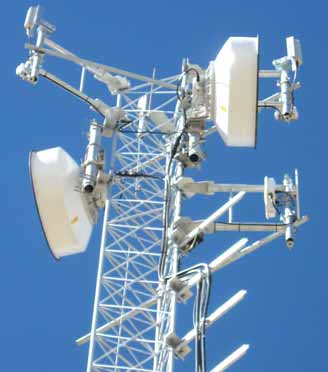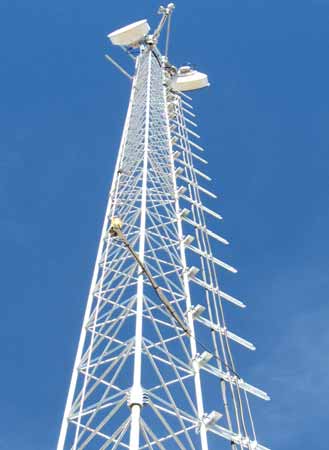
At Newmont Mining’s Carlin Operations in Nevada, dispatchers can view a bank of large-screen monitors to quickly
assess the status of the mine’s 45-truck haulage fleet.
Fleet Dispatch Systems Accelerate Mine Productivity
Advanced assignment algorithms, smarter graphics and system-wide hardware commonality enhance fleet dispatch system value, improve safety and provide a platform
for future equipment automation
By Russell A. Carter, Managing Editor

Nowhere throughout mine operations is this growing dependence on computersystem data gathering, analysis and decision- making more obvious than in haulage-fleet dispatching activities, where top-of-the-line fleet management suites have advanced well beyond the basic data-collection capabilities of their earlier versions and now can almost be regarded as expert systems, according to Ed Desjardins, senior manager–mining technology in Barrick Gold Corp.’s technical services group.
In a presentation at the 115th annual meeting of the Northwest Mining Association held in late November 2009 in Reno, Nevada, USA, Desjardins said fleet management systems not only help mines optimize the efficiency of their loading and haulage resources, but also can be used as a tool to improve safety as well as a platform to achieve additional automation in mining operations. Barrick, according to Desjardins, uses fleet management solutions from several major vendors including Caterpillar, Leica Geosystems/Jigsaw, Modular Mining and Wenco throughout its global operations.
He noted that the newest versions of fleet management systems offer highly sophisticated assignment algorithms in combination with less high-tech features that enhance system value and utility for the customer; these include a trend toward use of off-the-shelf hardware rather than proprietary designs for communications networks, along with improved onboard data storage capabilities so that information isn’t lost if network links fail, and smarter graphics design that does a better job of preventing trucks from getting “lost” in the system.
With the cost of large-screen LCD displays dropping below $1,000, Desjardins said it’s now easy and economical to equip dispatch stations with enough monitors to allow dispatchers to quickly see “everything that’s important” to the process. Furthermore, he suggested, at such low cost why not install large displays throughout the mine’s facilities to keep everybody aware and up-to-date on important operational status matters?
Despite the wide capabilities of the latest fleet management systems, it’s important to know exactly what factors are driving a mine’s productivity, profits and potential problems before making a selection, he cautioned—and then select the most appropriate system for that operation. Design the solution with close attention to system scalability and upgrade convenience. It’s not necessary to buy a full-blown mine management system if current conditions don’t warrant it: a number of vendors offer entrylevel products that can later be upgraded as necessary in concert with mine expansions and production changes.

Gold Quarry, Newmont’s largest surface operation in the Carlin area, is the first of its Nevada mines to use FleetCommander 3.0 and at the time of E&MJ’s visit was in the process of finetuning the system’s dispatching capabilities. The mine is a large operation that employs about 45 haul trucks—mostly Cat 793C or 793D models, with some 789s—plus Hitachi EX5500 and EX2500 hydraulic shovels and Cat 994F wheel loaders. Mining presently encompasses three pits—two in the North Area and one in the South Area—with significant variations in gold grade from pit to pit. Overall, according to Steve Micheli, Newmont’s MineStar analyst for the Carlin surface operations, as many as 100 different material types are encountered throughout the active mining areas. Roughly 300,000 tons of material are moved daily, with waste-to-ore ratios varying widely from day to day.
Cat estimates that this latest version of FleetCommander can provide a 5% boost in efficiency over the previous version. Newmont’s Micheli said that even in the early stages of FleetCommander 3.0 implementation, he noticed an approximate 15% improvement in truck productivity when allowing the system’s assignment algorithm to run unhindered by any restrictions—a practice that Cat recommends after significantly enhancing the product’s core truck assignment engine for the 3.0 version.
The assignment module, for example, now can improve safety by helping mine controllers manage exceptional conditions. For example, when a truck goes off course, the assignment engine honors any pit traffic rules for entrance to or direction of travel along roadways. Off-course trucks can then be safely reassigned.
The assignment module also offers new blending functionality. Although this feature wasn’t being used by Newmont for in-pit operations at the time of E&MJ’s site visit, it enables the mine controller to specify the type and quality of materials delivered to the dump, stockpile or processing plant. However, at Gold Quarry, ore from the secondary crushing plant is reloaded into haul trucks for delivery to one of two nearby mills; FleetCommander controls this operation, automatically recognizing truck type/capacity and loading the appropriate tonnage.
Other new features and improvements include tire management capabilities that enable the controller to set a maximum TKPH/TMPH for an individual truck or a class of trucks. The feature is integrated with KPI summaries to allow tire management performance reviews. New software also supports decision making by evaluating “what if” impacts of making changes to the production plan during the current shift. A new embedded dashboard display enables mine controllers in the office to view shift-based and realtime KPI and production variance information. Graphics such as gauges, histograms and trend lines enable dispatchers to quickly interpret system-wide data.
According to Cat, an upgraded site editor and computer-aided-design capabilities also can eliminate the need for an external mine-site design program. This is an improvement that Micheli particularly appreciates, enabling him to update the current mine model using the MineStar site editor rather than having to switch to third-party software.

Newmont has equipped the Carlin operations dispatch office with numerous large, flat-screen displays that allow dispatchers to view a wide variety of taskrelated information. Outside of the dispatch center, one of the most useful applications of these displays, according to Micheli, is a screen that allows drivers coming on duty at shift break to see which bus to take to reach their assigned truck—reducing delays and improving equipment utilization.
Also contributing to higher driver efficiency is the practice of collecting and providing specific machine health data— identifiable down to shift and truck number— to the mine’s learning and development staff, which uses this information to determine overall training trends and topics, as well as to conduct more specialized instruction for drivers in need of corrective action.
FleetCommander’s machine tracking module now gives mine controllers the ability to monitor machine location for an entire fleet, increasing overall site safety. A playback feature can help analyze haul road congestion and replay near-miss safety incidents.

The same hardware is used across all equipment types equipped with Fleet- Commander. Standardizing components reduces service parts inventory and decreases the burden on technicians. Additionally, the display and GPS receiver are now separate, which allows more cost effective repair of components.
The upgraded system now supports standard wireless protocols such as 802.11 and other IP wireless infrastructures. The expanded capabilities enable FleetCommander 3.0 to work with industry standard wireless communications networks, giving operations the opportunity to choose and implement infrastructure based on their site needs.
According to Cat, MineStar Fleet- Commander is a key building-block technology in the development of a Cat equipped autonomous mine. A key element in this advance is the Fleet- Commander 3.0 assignment engine, which the company claims provides closer integration with the digital mine site model. Additionally, algorithm optimization and software improvements are targeted to future management of the Cat Autonomous Haulage System and Autonomous Drill System.
 At Newmont’s Carlin Operations, Exalt split-mount radio systems configured to use the 11-GHz frequency band are used to further reduce the potential for interference in an area adjacent to another mine’s radio network.  Instead of having to dispatch personnel to reconfigure distant radios when necessary, the Exalt equipment allows Newmont communications technicians to perform most of those tasks from the office. As its expanding mining operations increase demand on sitewide communications capabilities, Newmont’s Carlin Operations recently took steps to increase bandwidth while maintaining round-the-clock uptime on its wireless network. The company worked with mining-industry communications specialist KNS Communications to upgrade its network and ultimately selected radio equipment provided by California, USA-based Exalt Communications. As a result, Newmont’s Carlin Operations now has a 200-megabit Ethernet backbone that exchanges dispatch, inventory, and control information with more than 150 pieces of mining machinery in service throughout its 24-mile-long tract of land holdings along the famous Carlin Trend in central Nevada. Cat’s Minestar system (see accompanying article) was deployed there in 2004 using 900-MHz radios on the equipment with a 5.8-GHz network backbone to support them. Network performance began to degrade over time, and in 2008 Newmont senior communications technician Boyd Burden began researching ways to upgrade the network. He consulted with KNS Communications, a designer and installer of industrial wireless communications systems based in Denver, Colorado. “We strive to have as little downtime on each piece of equipment as possible so it can produce safely 24 hours a day, 365 days a year, so we needed a network backbone that would never let us down,” said Burden. In addition to higher bandwidth, the network upgrade had to meet two other requirements. It had to offer bulletproof reliability to support the mine’s 24-hour operations; and had to be capable of being managed remotely to reduce costs associated with having to dispatch a technician to reconfigure radio systems that could be located up to 24 miles away. Working with KNS Communications, Burden selected Exalt microwave radio systems for the network backbone upgrade. “Exalt’s radios have a great reputation for high performance and high reliability, and we liked the built-in redundancy features along with the ability to choose both licensed and licenseexempt systems from the same vendor,” said Burden. To upgrade the network, KNS and Burden’s team deployed Exalt EX-11s radios over four hops, using the licensed 11-GHz frequency band to avoid interference with an adjacent mine’s radio systems. These systems use split-mount configurations so that the radio system electronics can be located inside weatherproof enclosures. For the other five hops, the teams opted for Exalt EX-5i radio systems configured to use the 5.6-GHz band. The radio hops reach from 7 to 10 miles each. According to Burden, since the deployment of the Exalt radio equipment in early 2009, the mine has experienced faster and more reliable communications. “Our data moves to and from the operations center much more quickly and reliably than before.” In addition to having more than enough backbone capacity for the mine’s operations well into the future, Newmont also gained higher efficiency by taking advantage of the radios’ ability to be remotely configured and managed. Rather than having to dispatch personnel to reconfigure distant radios, Burden now can perform most operations from his desk in the operations center. In the future, Burden’s team and KNS will be deploying more Exalt radio systems as they add three new hops to the network backbone. |